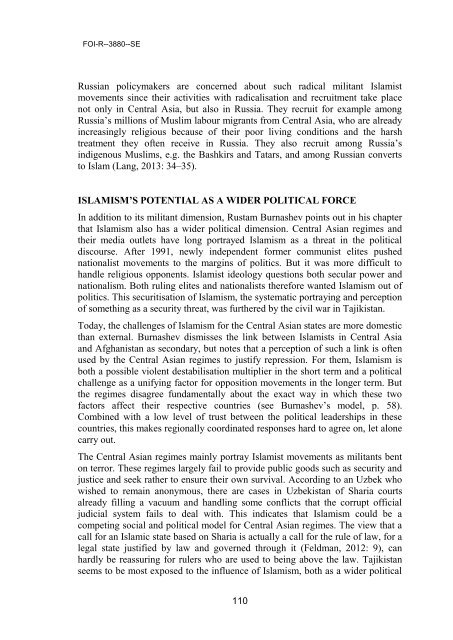foir_3880
foir_3880
foir_3880
Create successful ePaper yourself
Turn your PDF publications into a flip-book with our unique Google optimized e-Paper software.
FOI-R--<strong>3880</strong>--SE<br />
Russian policymakers are concerned about such radical militant Islamist<br />
movements since their activities with radicalisation and recruitment take place<br />
not only in Central Asia, but also in Russia. They recruit for example among<br />
Russia’s millions of Muslim labour migrants from Central Asia, who are already<br />
increasingly religious because of their poor living conditions and the harsh<br />
treatment they often receive in Russia. They also recruit among Russia’s<br />
indigenous Muslims, e.g. the Bashkirs and Tatars, and among Russian converts<br />
to Islam (Lang, 2013: 34–35).<br />
ISLAMISM’S POTENTIAL AS A WIDER POLITICAL FORCE<br />
In addition to its militant dimension, Rustam Burnashev points out in his chapter<br />
that Islamism also has a wider political dimension. Central Asian regimes and<br />
their media outlets have long portrayed Islamism as a threat in the political<br />
discourse. After 1991, newly independent former communist elites pushed<br />
nationalist movements to the margins of politics. But it was more difficult to<br />
handle religious opponents. Islamist ideology questions both secular power and<br />
nationalism. Both ruling elites and nationalists therefore wanted Islamism out of<br />
politics. This securitisation of Islamism, the systematic portraying and perception<br />
of something as a security threat, was furthered by the civil war in Tajikistan.<br />
Today, the challenges of Islamism for the Central Asian states are more domestic<br />
than external. Burnashev dismisses the link between Islamists in Central Asia<br />
and Afghanistan as secondary, but notes that a perception of such a link is often<br />
used by the Central Asian regimes to justify repression. For them, Islamism is<br />
both a possible violent destabilisation multiplier in the short term and a political<br />
challenge as a unifying factor for opposition movements in the longer term. But<br />
the regimes disagree fundamentally about the exact way in which these two<br />
factors affect their respective countries (see Burnashev’s model, p. 58).<br />
Combined with a low level of trust between the political leaderships in these<br />
countries, this makes regionally coordinated responses hard to agree on, let alone<br />
carry out.<br />
The Central Asian regimes mainly portray Islamist movements as militants bent<br />
on terror. These regimes largely fail to provide public goods such as security and<br />
justice and seek rather to ensure their own survival. According to an Uzbek who<br />
wished to remain anonymous, there are cases in Uzbekistan of Sharia courts<br />
already filling a vacuum and handling some conflicts that the corrupt official<br />
judicial system fails to deal with. This indicates that Islamism could be a<br />
competing social and political model for Central Asian regimes. The view that a<br />
call for an Islamic state based on Sharia is actually a call for the rule of law, for a<br />
legal state justified by law and governed through it (Feldman, 2012: 9), can<br />
hardly be reassuring for rulers who are used to being above the law. Tajikistan<br />
seems to be most exposed to the influence of Islamism, both as a wider political<br />
110


